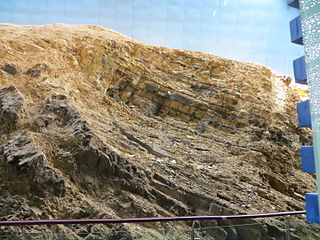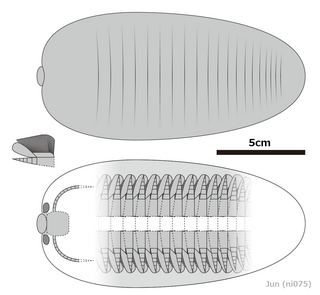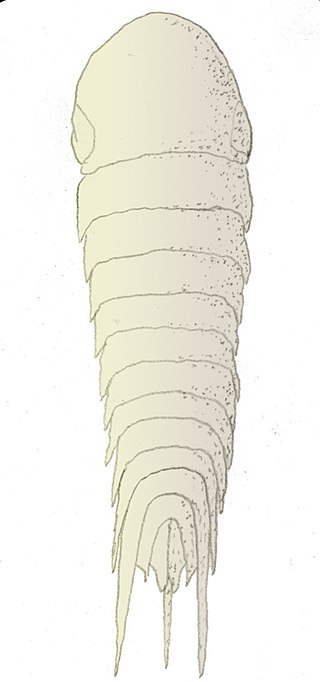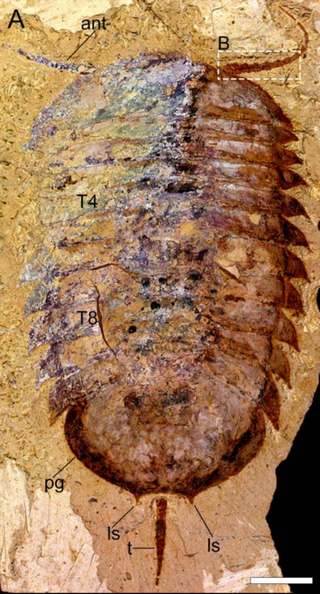
The Maotianshan Shales (帽天山页岩) are a series of Early Cambrian sedimentary deposits in the Chiungchussu Formation, famous for their Konservat Lagerstätten, deposits known for the exceptional preservation of fossilized organisms or traces. The Maotianshan Shales form one of some forty Cambrian fossil locations worldwide exhibiting exquisite preservation of rarely preserved, non-mineralized soft tissue, comparable to the fossils of the Burgess Shale of British Columbia, Canada. They take their name from Maotianshan Hill in Chengjiang County, Yunnan Province, China.

Microdictyon is an extinct armoured worm-like panarthropod coated with net-like scleritic plates, known from the Early Cambrian Maotianshan shale of Yunnan China and other parts of the world. Microdictyon is part of the ill-defined taxon – Lobopodia – that includes several other odd worm-like animals that resembling worm with legs, such as Hallucigenia, Onychodictyon, Cardiodictyon, Luolishania, and Paucipodia. The isolated sclerites of Microdictyon are known from other Lower Cambrian deposits. Microdictyon sclerites appear to have moulted; one sclerite seems to have been preserved during ecdysis.

Nectocaris is a genus of squid-like animal of controversial affinities known from the Cambrian period. The initial fossils were described from the Burgess Shale of Canada. Other similar remains possibly referrable to the genus are known from the Emu Bay Shale of Australia and Chengjiang Biota of China.

Yunnanocephalus is a genus of ptychopariid trilobite. It lived during the late Atdabanian and Botomian stages, in what are currently Antarctica, Australia and China. It was a "moderately common" member of the Chengjiang Fauna. Yunnanocephalus is the only genus currently assigned to the Yunnanocephalidae family.

Saperion is an extinct genus of trilobite-like arthropod. It lived during the late Atdabanian stage, which lasted from 521 to 514 million years ago during the early part of the Cambrian Period. It was found in the Maotianshan Shales of Yunnan, China. Similar to the closely-related Skioldia and Tegopelte, the head shield and trunk tergites were fused into a single plate. There are about 19 furrows indicating the original trunk segments. a small anterior sclerite articulated to the front of its head. A pair of antennae and lateral eyes located ventrally behind the anterior sclerite, lateral to the hypostome. Saperion reached 151 mm in length and had nearly 25 pairs of biramous limbs for walking.

Acanthomeridion is an extinct arthropod found in the Chengjiang fauna deposits of China. In 1997, it was placed in its own, monotypic family, Acanthomeridiidae. It is known from eight specimens, all found in China.

Chengjiang is a city located in Yuxi, Yunnan Province, China, just north of Fuxian Lake.

Pectocaris is an extinct genus of bivalved arthropods from the Cambrian Maotianshan Shales, Yunnan Province of China. There are currently four known species within the genus.

Miraluolishania is an extinct lobopodian known from Chengjiang County in China. It is remarkable for the possession of lensed pit-eyes. The only species, Miraluolishania haikouensis, was described from the Maotianshan Shales at Haikou by Jianni Liu and Degan Shu in 2004. In 2009, a team of palaeontologists at the Yunnan University, led by Xiaoya Ma reported the discovery of 42 other specimens from Haikou. With the help of Swiss palaeontologist Jan Bergström, Ma and Hou came to the conclusion that all the specimens were the same species as Luolishania; another lobopod discovered from the Chengjian in 1989. Chengjian is 40 kms from Haikou and the fossil fauna are different. A reassessment by Liu and Shu's team at the Northwest University in 2008 established that Luolishania and Miraluolishania are distinct animals.
The genus Trigoides is known from fossils from the Chengjiang Lagerstätte. It is proposed to be a type of ctenophore.

Eldoniids or eldonioids are an extinct clade of enigmatic disc-shaped animals which lived in the early to middle Paleozoic. They are characterized by their "medusoid" (jellyfish-shaped) bodies, with the form of a shallow dome opening below to an offset mouth supplemented by filamentous tentacles. Internally, they have a distinctive C-shaped cavity encompassing the gut, as well as hollow radial (radiating) structures arranged around a central ring canal. Most eldoniids are soft-bodied and can only be preserved in lagerstätten, but a few species may have hosted mineralized deposits. Historically, the affinities of eldoniids was enigmatic; recently, they been assessed as cambroernid deuterostomes. Their lifestyle is still an unresolved question; some authors reconstruct eldoniids as free-floating planktonic predators similar to jellyfish, while others argue that they were passive detritivores, embedded within the seabed for much of their life.

Allonnia is a genus of coeloscleritophoran known as complete scleritomes from the Middle Cambrian Burgess Shale. It is also a constituent of the small shelly fauna.
Stage 2 of the Cambrian is the unnamed upper stage of the Terreneuvian Series. It lies atop the Fortunian and below Stage 3 of the Cambrian. It is commonly referred to as the Tommotian, after the Cambrian stratigraphy of Siberia. Neither the upper nor lower boundary has yet been defined by the International Commission on Stratigraphy. The preferred definitions for the lower boundary are the first appearance of the molluscs Watsonella crosbyi or Aldanella attleborensis around 529 million years ago. The correlation between the lowest occurrences of A. attleborensis and W. crosbyi with the Zhujiaqing positive carbon isotope excursion (ZHUCE) has led to the conclusion that the combination of these two markers are a reliable indicator of the boundary between the Fortunian and Stage 2. The proposed upper boundary might be the first appearance of trilobites around 521 million years ago.
Protohertzina is a genus of conodonts or, possibly, Chaetognaths, found at the beginning of the Cambrian explosion.

Onychodictyon is a genus of extinct lobopodian known from the Lower Cambrian Chengjiang Maotianshan Shales in the Yunnan Province in China. It was characterized by a stout body covered by fleshy papillae and pairs of sclerotized plates with spines, representing part of the diverse "armoured lobopodians" alongside similar forms such as Microdictyon and Hallucigenia.

Retifacies abnormalis is an extinct arthropod that lived in the lower Cambrian. Its fossil remains have been found in the Maotianshan Shales of Yunnan, China. It is a member of the Artiopoda, and closely related to Pygmaclypeatus.

Yicaris dianensis is a species of microscopic pancrustacean found in the Yu’anshan Formation, Yunnan Province, China. Yicaris' discovery is notable because its age suggests that true crustaceans already existed as far back in time as Early Cambrian, much earlier than other fossils known from the Middle and Late Cambrian. Its closest living relatives are believed to be Cephalocaridans.

Acinocricus is a genus of extinct panarthropod belonging to the group Lobopodia and known from the middle Cambrian Spence Shale of Utah, United States. As a monotypic genus, it has one species Acinocricus stichus. The only lobopodian discovered from the Spence Shale, it was described by Simon Conway Morris and Richard A. Robison in 1988. Owing to the original fragmentary fossils discovered since 1982, it was initially classified as an alga, but later realised to be an animal belonging to Cambrian fauna.

Lenisambulatrix is a genus of extinct worm belonging to the group Lobopodia and known from the Lower Cambrian Maotianshan shale of China. It is represented by a single species L. humboldti. The incomplete fossil was discovered and described by Qiang Ou and Georg Mayer in 2018. Due to its missing parts, its relationship with other lobopodians is not clear. It shares many structural features with another Cambrian lobopodian Diania cactiformis, a fossil of which was found alongside it.
Hou Xian-guang is a Chinese paleontologist at Yunnan University who made key discoveries in the Cambrian life of China around 518 myr. His first discovery of animal fossils from the Cambrian sediments at Chengjiang County, Yunnan Province, led to the establishment of the Chengjiang biota, an assemblage of various life forms during the Cambrian Period. The discovery of the Chengjiang biota, remarked as "among the most spectacular in this [20th] century", added to the better understanding of how animal forms originated and evolved during the so-called Cambrian explosion.















